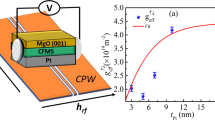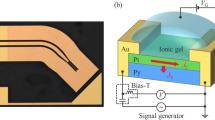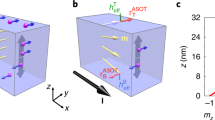Abstract
The spin Hall effect converts charge current to pure spin currents in orthogonal directions in materials that have significant spin–orbit coupling. The efficiency of the conversion is described by the spin Hall angle (SHA). The SHA can most readily be inferred by using the generated spin currents to excite or rotate the magnetization of ferromagnetic films or nano-elements via spin-transfer torques. Some of the largest spin-torque-derived spin Hall angles (ST-SHA) have been reported in platinum. Here we show, using spin-torque ferromagnetic resonance measurements, that the transparency of the Pt–ferromagnet interface to the spin current plays a central role in determining the magnitude of the ST-SHA. We measure a much larger ST-SHA in Pt/cobalt (∼0.11) compared to Pt/permalloy (∼0.05) bilayers when the interfaces are assumed to be completely transparent. Taking into account the transparency of these interfaces, as derived from spin-mixing conductances, we find that the intrinsic SHA in platinum has a much higher value of 0.19 ± 0.04 as compared to the ST-SHA. The importance of the interface transparency is further exemplified by the insertion of atomically thin magnetic layers at the Pt/permalloy interface that we show strongly modulates the magnitude of the ST-SHA.
This is a preview of subscription content, access via your institution
Access options
Subscribe to this journal
Receive 12 print issues and online access
$209.00 per year
only $17.42 per issue
Buy this article
- Purchase on Springer Link
- Instant access to full article PDF
Prices may be subject to local taxes which are calculated during checkout





Similar content being viewed by others
References
D’yakonov, M. I. & Perel’, V. I. Possibility of orienting electron spins with current. J. Exp. Theor. Phys. Lett. 13, 467–469 (1971).
Hirsch, J. E. Spin Hall effect. Phys. Rev. Lett. 83, 1834–1837 (1999).
Zhang, S. Spin Hall effect in the presence of spin diffusion. Phys. Rev. Lett. 85, 393–396 (2000).
Jungwirth, T., Wunderlich, J. & Olejnik, K. Spin Hall effect devices. Nature Mater. 11, 382–390 (2012).
Liu, L. et al. Spin-torque switching with the giant spin Hall effect of tantalum. Science 336, 555–558 (2012).
Liu, L., Lee, O. J., Gudmundsen, T. J., Ralph, D. C. & Buhrman, R. A. Current-induced switching of perpendicularly magnetized magnetic layers using spin torque from the spin Hall effect. Phys. Rev. Lett. 109, 096602 (2012).
Ryu, K-S., Thomas, L., Yang, S-H. & Parkin, S. S. P. Chiral spin torque at magnetic domain walls. Nature Nanotech. 8, 527–533 (2013).
Ryu, K-S., Yang, S-H., Thomas, L. & Parkin, S. S. P. Chiral spin torque arising from proximity-induced magnetization. Nature Commun. 5, 3910 (2014).
Thiaville, A., Rohart, S., Jue, E., Cros, V. & Fert, A. Dynamics of Dzyaloshinskii domain walls in ultrathin magnetic films. Europhys. Lett. 100, 57002 (2012).
Khvalkovskiy, A. V. et al. Matching domain wall configuration and spin–orbit torques for very efficient domain-wall motion. Phys. Rev. B 87, 020402 (2013).
Liu, L., Moriyama, T., Ralph, D. C. & Buhrman, R. A. Spin-torque ferromagnetic resonance induced by the spin Hall effect. Phys. Rev. Lett. 106, 036601 (2011).
Kondou, K., Sukegawa, H., Mitani, S., Tsukagoshi, K. & Kasai, S. Evaluation of spin Hall angle and spin diffusion length by using spin current-induced ferromagnetic resonance. Appl. Phys. Expr. 5, 073002 (2012).
Mellnik, A. R. et al. Spin-transfer torque generated by a topological insulator. Nature 511, 449–451 (2014).
Pai, C-F. et al. Spin transfer torque devices utilizing the giant spin Hall effect of tungsten. Appl. Phys. Lett. 101, 122404 (2012).
Slonczewski, J. Current-driven excitation of magnetic multilayers. J. Magn. Magn. Mater. 159, L1–L7 (1996).
Kittel, C. On the theory of ferromagnetic resonance absorption. Phys. Rev. 73, 155–161 (1948).
Chen, Y-T. et al. Theory of spin Hall magnetoresistance. Phys. Rev. B 87, 144411 (2013).
Brataas, A., Nazarov, Y. V. & Bauer, G. E. W. Finite-element theory of transport in ferromagnet–normal metal systems. Phys. Rev. Lett. 84, 2481–2484 (2000).
Tserkovnyak, Y., Brataas, A., Bauer, G. E. W. & Halperin, B. I. Nonlocal magnetization dynamics in ferromagnetic heterostructures. Rev. Mod. Phys. 77, 1375–1421 (2005).
Zwierzycki, M., Tserkovnyak, Y., Kelly, P. J., Brataas, A. & Bauer, G. E. W. First-principles study of magnetization relaxation enhancement and spin transfer in thin magnetic films. Phys. Rev. B 71, 064420 (2005).
Tserkovnyak, Y., Brataas, A. & Bauer, G. E. W. Spin pumping and magnetization dynamics in metallic multilayers. Phys. Rev. B 66, 224403 (2002).
Jiao, H. & Bauer, G. E. W. Spin backflow and ac voltage generation by spin pumping and the inverse spin Hall effect. Phys. Rev. Lett. 110, 217602 (2013).
Ando, K. et al. Inverse spin-Hall effect induced by spin pumping in metallic system. J. Appl. Phys. 109, 103913 (2011).
Mosendz, O. et al. Quantifying spin Hall angles from spin pumping: Experiments and theory. Phys. Rev. Lett. 104, 046601 (2010).
Barati, E., Cinal, M., Edwards, D. M. & Umerski, A. Gilbert damping in magnetic layered systems. Phys. Rev. B 90, 014420 (2014).
Kalarickal, S. S. et al. Ferromagnetic resonance linewidth in metallic thin films: Comparison of measurement methods. J. Appl. Phys. 99, 093909 (2006).
Czeschka, F. D. et al. Scaling behavior of the spin pumping effect in ferromagnet–platinum bilayers. Phys. Rev. Lett. 107, 046601 (2011).
Carr, W. J. Intrinsic magnetization in alloys. Phys. Rev. 85, 590–594 (1952).
Oogane, M. et al. Magnetic damping in ferromagnetic thin films. Jpn. J. Appl. Phys. 45, 3889–3891 (2006).
Mankovsky, S., Ködderitzsch, D., Woltersdorf, G. & Ebert, H. First-principles calculation of the Gilbert damping parameter via the linear response formalism with application to magnetic transition metals and alloys. Phys. Rev. B 87, 014430 (2013).
McGuire, T. R. & Potter, R. I. Anisotropic magnetoresistance in ferromagnetic 3d alloys. IEEE Trans. Magn. 11, 1018–1038 (1975).
Bailey, W. E. et al. Detection of microwave phase variation in nanometre-scale magnetic heterostructures. Nature Commun. 4, 2025 (2013).
Parkin, S. S. P. Origin of enhanced magnetoresistance of magnetic multilayers- spin-dependent scattering from magnetic interface states. Phys. Rev. Lett. 71, 1641–1644 (1993).
Rojas-Sánchez, J. C. et al. Spin pumping and inverse spin Hall effect in platinum: The essential role of spin-memory loss at metallic interfaces. Phys. Rev. Lett. 112, 106602 (2014).
Liu, Y., Yuan, Z., Wesselink, R. J. H., Starikov, A. A. & Kelly, P. J. Interface enhancement of Gilbert damping from first principles. Phys. Rev. Lett. 113, 207202 (2014).
Guo, G. Y., Niu, Q. & Nagaosa, N. Anomalous Nernst and Hall effects in magnetized platinum and palladium. Phys. Rev. B 89, 214406 (2014).
Levy, P. M. & Mertig, I. in Spin Dependent Transport in Magnetic Nanostructures (eds Maekawa, S. & Shinjo, T.) (Taylor & Francis, 2002).
Acknowledgements
We gratefully acknowledge help from C. Lada in designing the ST-FMR measurement system and discussions with T. Phung. W. H. also acknowledges support from the 1000 Talents Program for Young Scientists of China and the Collaborative Innovation Center of Quantum Matter, China.
Author information
Authors and Affiliations
Contributions
W.Z., W.H., X.J. and S.S.P.P. designed the experiments. W.Z. performed the fabrication and measurements of the devices with help from W.H. W.Z., W.H. and X.J. analysed the data. X.J., W.H. and S-H.Y. grew the films. S.S.P.P. proposed and supervised the studies. W.Z., W.H. and S.S.P.P. wrote the manuscript.
Corresponding author
Ethics declarations
Competing interests
The authors declare no competing financial interests.
Supplementary information
Supplementary Information
Supplementary Information (PDF 2765 kb)
Rights and permissions
About this article
Cite this article
Zhang, W., Han, W., Jiang, X. et al. Role of transparency of platinum–ferromagnet interfaces in determining the intrinsic magnitude of the spin Hall effect. Nature Phys 11, 496–502 (2015). https://doi.org/10.1038/nphys3304
Received:
Accepted:
Published:
Issue Date:
DOI: https://doi.org/10.1038/nphys3304
This article is cited by
-
Observation of anti-damping spin–orbit torques generated by in-plane and out-of-plane spin polarizations in MnPd3
Nature Materials (2023)
-
Observation of the crossover between metallic and insulating regimes of the spin Hall effect
Communications Physics (2022)
-
Collective skyrmion motion under the influence of an additional interfacial spin-transfer torque
Scientific Reports (2022)
-
Current-induced switching of proximity-induced ferromagnetic surface states in a topological insulator
Nature Communications (2021)
-
Giant charge-to-spin conversion in ferromagnet via spin-orbit coupling
Nature Communications (2021)



